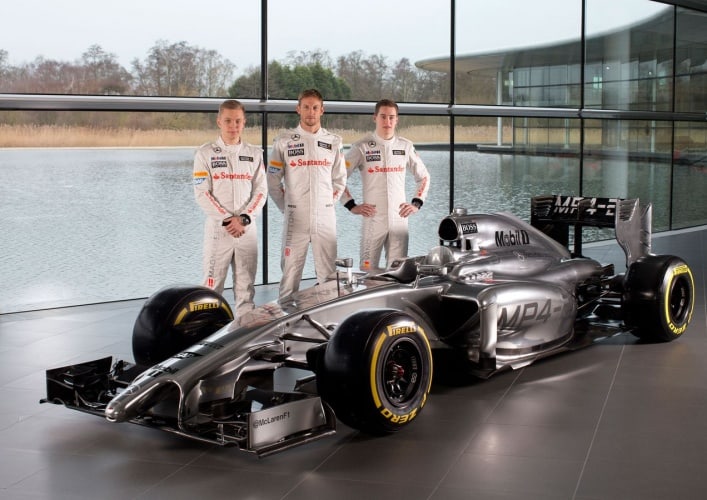As you may have read in my previous Engineer Guest Blog - “Shaping the Sound of Future Vehicles” - the NVH of hybrid vehicles is a subject which is currently being debated in the automotive industry. Awareness of this topic recently came to the fore when rule changes in Formula 1 sparked a heated debate over the noise of F1 cars. The switch from 2.4 litre naturally aspirated V8 engines to 1.6 litre V6 turbos with extensive hybrid technology (ERS incorporating MGU-K and MGU-H) this year has meant that the cars are now sound substantially quieter than their predecessors. The move has caused some spectators to complain that the spectacle of F1 has been diminished, as the sound of the engines had an emotional connection with fans and set the cars apart from those in other formulae.
Both the commercial rights holder Formula One Management (FOM) and the majority of the teams want their vehicles to sound as powerful as possible for marketing purposes, however the powertrain architecture stipulated by the new regulations has not been conducive towards this. Understandably the teams’ effort is focused towards improving performance on the track as this is what wins championships, rather than refining the noise of the engines. As the need for enhancing the noise of the cars has only recently been highlighted, the difficulty the teams are now facing is tuning the cars’ exhausts so they sound appealing without compromising performance or breaking the newly implemented rules.

One of the main aspects that F1 teams focus on when engineering an F1 vehicle is the implementation of CAE techniques. CAE is used to accurately predict the combustion process, allowing the engineer to predict the performance, fuel consumption and emissions of the power unit and to improve fuel saving – all of which are key contributors towards a winning car. NVH engineers are able to use CAE to calculate the noise contribution from the power unit by modelling pressure fluctuations in the system all the way from the combustion chamber to the exhaust and intake orifices. This therefore allows engineers to accurately predict the radiated exhaust and intake noise from the vehicle.
The perceived performance of a car is strongly linked to both its noise level and quality. In the past, MIRA has recorded the sound of performance modified vehicles together with their performance on a calibrated rolling road. The perception of the owners was that the vehicles had far more power and improved performance when in reality modifications such as ‘free-flow’ intake systems and large diameter exhaust systems increased overall noise, whilst having little effect on the vehicle power output and performance when compared to the standard vehicle. Many of the world’s OEMs - particularly the ‘manufacturer teams’ in F1 who also make road cars such as Ferrari, Mercedes and McLaren – will be carefully considering the implications of quieter sounding F1 cars since they were informed of the rule changes. Because F1 sits at the pinnacle of motorsport and is the primary platform for global automotive marketing, manufacturers are concerned that having quieter sounding thoroughbred racing machines may reduce the appeal of their production cars to potential customers, as the sound would be less emotive.
’As the need for enhancing the noise of the cars has only recently been highlighted, the difficulty the teams are now facing is tuning the cars’ exhausts so they sound appealing without compromising performance or breaking the newly implemented rules
Manufacturers in the automotive industry (particularly those offering sports and luxury models) are also subject to similar regulatory pressures. In an ideal world they would produce vehicles which sound as powerful and aggressive as possible in order to enhance the marketability of their cars, but like in F1 – regulations (or in this case legislation) prevents them from doing this. To get around this problem automotive manufacturers go to extraordinary lengths in order to develop and refine the audio brand of their road-going products through meticulous NVH testing and development. For example some of them apply clever engineering techniques such as active NVH to make the sounds inside the cabin provide the driver with a feeling of enhanced engine performance whilst ensuring that the vehicle stays within the limits of prescribed external noise emission legislation. This raises the question whether similar techniques could be adopted in F1. If they could, the teams would only be able to make small improvements to the noise quality of the vehicle whilst maintaining the performance, but you could question whether this matters bearing in mind the majority of the spectators in F1 watch the races on the television at home.
A similar process can be applied to the sound quality tuning programmes that MIRA conducts for OEMs. Here the NVH characteristics of a car are reproduced in the NVH simulator which can be either a true-to-life reproduction of an actual vehicle or the prediction of a concept vehicle. NVH engineers at MIRA then tune the sound of the vehicles to meet the aspirations of the manufacturer and the desires of the customers. Linking the knowledge of automotive engineers with television sound engineers could allow the F1 brand to sound as exhilarating as ever.
It will be interesting to see how the debate surrounding NVH in F1 unfolds over the coming months, but I’m particularly fascinated to see if this heightened sense of awareness surrounding NVH in hybrid vehicles could be the turning point for future NVH development.










Water Sector Talent Exodus Could Cripple The Sector
Well let´s do a little experiment. My last (10.4.25) half-yearly water/waste water bill from Severn Trent was £98.29. How much does not-for-profit Dŵr...